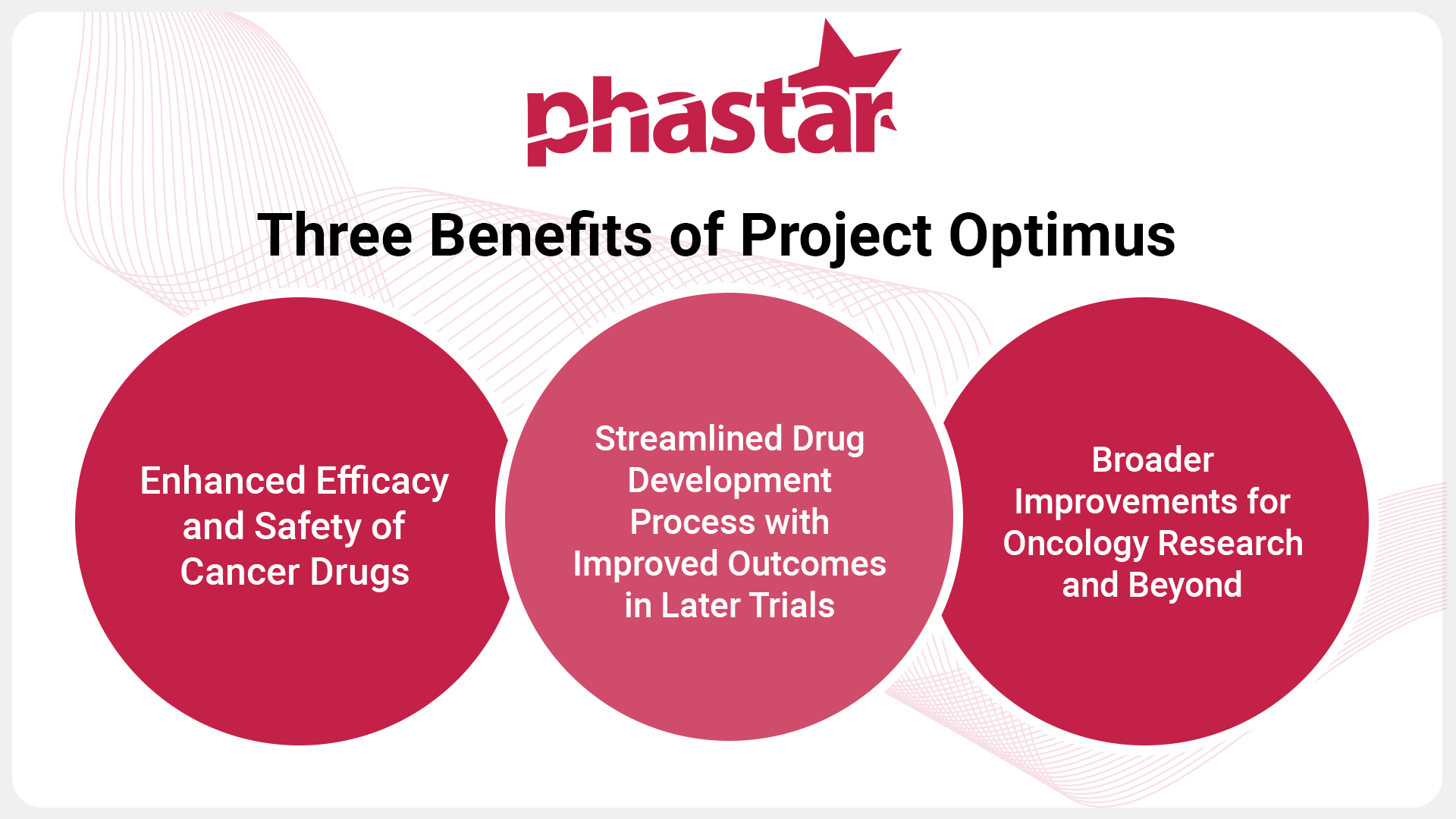Introduction
With the launch of Project Optimus, the FDA is overhauling the paradigm of dose optimization and selection in oncology drug development. This initiative tackles the problem of poorly characterized doses and schedules, which can result in increased toxicity without enhancing efficacy.
This transformation will require substantial changes in the design and execution of early phase trials, but it is poised to bring multiple benefits to researchers, clinicians, and patients.
Optimizing drug dosing can enhance patient safety, improve clinical trial success rates, and lead to more efficient drug approvals. This blog will explore how these improvements can positively impact both patients and drug developers.
Three Benefits of Project Optimus

Enhanced Efficacy and Safety of Cancer Drugs
One of the most significant benefits of Project Optimus is its potential to improve the efficacy and safety of cancer treatments. Traditional dosing strategies often result in high toxicity levels without necessarily providing additional therapeutic benefits.
By optimizing dosing regimens, Project Optimus aims to maximize the therapeutic effect while minimizing adverse reactions and a reduction of debilitating or chronic side effects, leading to better patient outcomes. [1]
Traditional cancer therapies, while effective in combating tumors, can lead to a range of adverse effects, including fatigue, nausea, neuropathy, and organ damage, especially when taken over long periods. These side effects can significantly impact a patient’s quality of life. [2]
By optimizing dosages and personalizing treatment plans, it ensures that patients receive the most effective therapy with the least possible harm, making cancer treatment more tolerable and sustainable over time.
Streamlined Drug Development Process with Improved Outcomes in Later Trials
The traditional drug development process for oncology treatments is often lengthy and costly, with many promising compounds failing in late-stage trials due to toxicity issues. Project Optimus proposes integrating dose optimization studies early in the development process. [3]
By identifying the optimal dose earlier, pharmaceutical companies can design more efficient clinical trials, reducing the likelihood of late-stage failures. This not only accelerates the availability of new treatments but also ensures that patients receive the most effective and safest doses from the outset.
Catch up on the full webinar here
Broader Improvements for Oncology Research and Beyond
Project Optimus is poised to have a transformative impact on oncology research. By shifting the focus from simply identifying a maximum tolerated dose (MTD) to a more optimal dose, the initiative encourages a more scientific and patient-centric approach to drug development. [4] This can lead to a deeper understanding of the pharmacokinetics and pharmacodynamics of oncology drugs, contributing to more effective treatment strategies. [5]
Additionally, Project Optimus can set a precedent for other therapeutic areas, encouraging similar dose-optimization approaches in fields beyond oncology. The principles of dose optimization can be applied to various medical disciplines, potentially improving patient outcomes across a wide range of diseases, such as autoimmune diseases where high toxicity treatments are often the norm. [6]
Summary
Project Optimus represents a significant step forward to maximize patient outcomes in oncology. By focusing on dose optimization, this innovative initiative can improve the efficacy and safety of cancer treatments and enhance drug development. The collaborative efforts of stakeholders and ongoing research and clinical trial development will be key to realizing the full benefits of Project Optimus.
However, with implementation of any new initiative there will be potential hurdles to overcome. Look out for our next blog in the series which will focus on highlighting the key challenges that may be faced when ensuring adherence to Project Optimus.
References
[1] Murphy, R., Halford, S., & Symeonides, S. N. (2023). Project Optimus, an FDA Initiative: Considerations for Cancer Drug Development Internationally, from an Academic Perspective. Frontiers in Oncology, 13, 1144056. https://doi.org/10.3389/fonc.2023.1144056
[2] Anand, U., Dey, A., Singh Chandel, A. K., Sanyal, R., Mishra, A., Pandey, D. K., De Falco, V., Upadhyay, A., Kandimalla, R., Chaudhary, A., Dhanjal, J. K., Dewanjee, S., Vallamkondu, J., & Pérez de la Lastra, J. M. (2023). Cancer chemotherapy and beyond: Current status, drug candidates, associated risks and progress in targeted therapeutics. Genes & Diseases, 10(4), 1367-1401. https://doi.org/10.1016/j.gendis.2022.02.007
[3] Project Optimus Reforming the Dose Optimization and Dose Selection Paradigm in Oncology. U.S. Food and Drug Administration. https://www.fda.gov/about-fda/oncology-center-excellence/project-optimus
[4] Alger, E., Van Zyl, M., Aiyegbusi, O. L., Chuter, D., Dean, L., Minchom, A., & Yap, C. (2024). Patient and public involvement and engagement in the development of innovative patient-centric early phase dose-finding trial designs. Research Involvement and Engagement, 10(1), 63. https://doi.org/10.1186/s40900-024-00599-7
[5] Papachristos, A., Patel, J., Vasileiou, M., & Patrinos, G. P. (2023). Dose optimization in oncology drug development: The emerging role of pharmacogenomics, pharmacokinetics, and pharmacodynamics. Cancers, 15(12), 3233. https://doi.org/10.3390/cancers15123233
[6] Lallana, E. C., & Fadul, C. E. (2011). Toxicities of immunosuppressive treatment of autoimmune neurologic diseases. Current Neuropharmacology, 9(3), 468–477. https://doi.org/10.2174/157015911796557939
About Phastar
As a leading global biometrics contract research organization, we are committed to partnering with stakeholders to navigate clinical design complexities and ensure compliance with Project Optimus. Engaging with statistical experts early on and throughout the process is essential to ensure the best possible outcomes for your clinical trials.
Interested in learning more?



